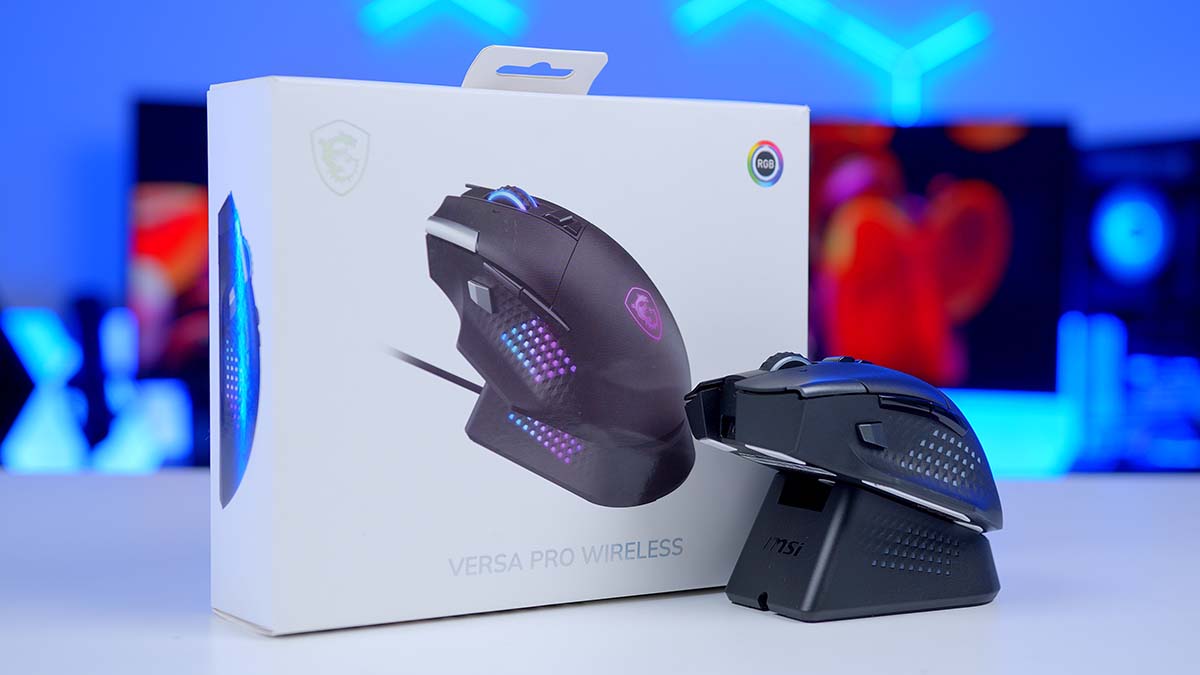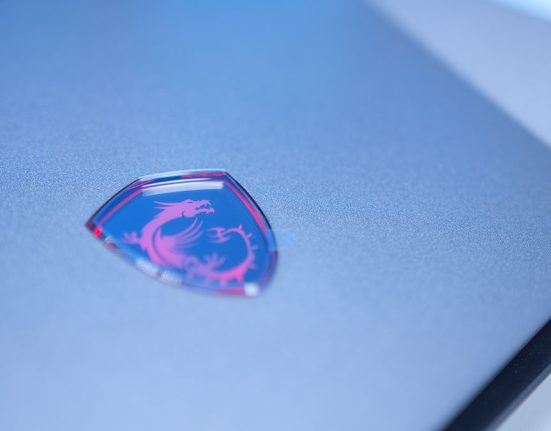The MSI VERSA PRO Wireless is a familiar-looking ergonomic design offering gamers high polling rates and unhindered wireless connectivity. With 13 programmable buttons, a high-quality optical sensor, and fully wireless charging, the VERSA PRO targets gamers who want to play their favourite titles without the encumbrance of wires or a low-speed connection.
However, upon initial inspection, the VERSA PRO Wireless appears to be incredibly similar to some of Logitech’s older mice, notably the G502 series. MSI are not a peripherals manufacturer first, so going head-to-head with one of the world’s most popular providers of mice and keyboards is going to be some very tough competition for MSI. We’re hoping that the VERSA PRO Wireless has a few tricks up its sleeve that separate it from its key competitors.
Which is why we’ve put the VERSA PRO Wireless to the test in this review. I’ve spent a few days with the VERSA PRO Wireless analysing its features, design, specs and performance to see how it fares against the rest of the market.
Buy the MSI VERSA PRO Wireless on:
Specification
Upon initial inspection, the MSI VERSA PRO Wireless has a decent set of specs. Regarding connectivity, gamers have the choice between three options: wired via a 2m USB 2.0 Type-A cable, a USB-A 2.4GHz dongle, or Bluetooth 5.3. Bar wired, 2.4GHz is always going to be the strongest form of wireless connectivity compared to Bluetooth, which is our go-to recommendation if you’re trying to avoid potential lag or misinputs.
The VERSA PRO Wireless utilises a PixArt PAW-3395 sensor, rated for up to 26000 DPI when configured through MSI Center, versus 6400 DPI when using the onboard presets. It’s good to see the use of an industry-standard sensor, PixArt, which is used across a variety of different mouse brands and is incredibly reliable. I think it’s a shame that the 26000 DPI isn’t immediately accessible without the use of software. MSI Center can be troublesome, so you’re essentially restricted to relatively low DPI sensitivity unless you’re willing to install their application, which may cause potential conflicts.

In terms of battery life, MSI claims that the VERSA PRO Wireless can last up to 80 hours, and it’ll take 1.5 hours via cable for a full recharge. This version of the mouse does come with a wireless Qi charging dock, which can be handy once you’ve finished your session of gaming, but the steep rise in price compared to the standalone mouse is going to be a turn-off for a lot of gamers.
This mouse weighs a rather minuscule 97g, which I’d say is reasonably lightweight. It doesn’t quite compare to the super lightweight mice we’ve seen, like the Logitech G Pro X Superlight, which weighs 63g. However, I think it’s impressive that they’ve managed to keep the weight down, considering the amount of hardware inside this peripheral.
| Key Specs | MSI VERSA PRO Wireless |
|---|---|
| Connectivity | Wired 2.4GHz Bluetooth |
| Sensor | PixArt PAW-3395 (26000 DPI) |
| Polling Rate | 1000Hz |
| Battery Life | 80 Hours |
| Mouse Feet | N/A |
| Wired Connectivity | USB 2.0 |
| Cable | 2m |
| Weight | 97g |
| Colours | Black |
| MSRP | $109.99 $179.99 w/Dock |
The last quality to cover on the specs front is the Manufacturer’s Suggested Retail Price (MSRP). The mouse on its own is $109.99, which puts it pretty much on par with the Logitech G502 and G502 X Lightspeed, priced at $99.99 and $119.99, respectively. I don’t think the price is unfair per se, but it immediately puts the VERSA PRO Wireless in a tough spot, because the specs side-by-side are incredibly similar to those of the G502 X range, which is widely regarded as one of the best ergonomic gaming mice on the market.
The key differentiator here is the price of the VERSA PRO Wireless with the dock, at $179.99. Spending $60 extra for a dock is incredibly disappointing. While I understand that it has wireless charging, the dock itself isn’t anything special, and it requires you to relinquish using the mouse entirely to charge it. I think the VERSA PRO Wireless would offer a much better value proposition if the base $110 model just came with the dock. This would be a particularly impressive feature, making the VERSA PRO stand out compared to Logitech’s Power Play system, which can be pretty expensive.
MSI VERSA PRO Wireless Design
One of the significant advantages of the VERSA PRO Wireless over a run-of-the-mill mouse is its ergonomic design. The VERSA PRO Wireless is designed to fit the hand more comfortably, accommodating a range of different grip styles.

On the left side of the mouse is a small ledge that acts as a thumb rest. This sits directly below the “Snipe” button and the forward and backwards buttons. The thumbrest and contoured texture on the side of the mouse make it easier to hold onto and reduce strain, which is ideal if you’re using the mouse for a prolonged amount of time. However, I think MSI could have better positioned the RGB. There is a small array of LEDs situated on the left side of the mouse, which will be covered as soon as you rest your thumb.

In terms of buttons, the top centre button changes the scroll wheel from smooth to notched scrolling, which can be handy if you find yourself scrolling a lot. The mouse wheel can also be pressed left and right, allowing for more customisable inputs. There’s also a mute button positioned at the top of the left click, which can be helpful if you need to mute your microphone quickly.

On the underside of the VERSA PRO Wireless, you’ll find some plastic skates, the charging puck, 2.4GHz dongle, connectivity switch and DPI button. MSI doesn’t clarify on the product page of the VERSA PRO Wireless whether the skates are 100% PTFE, but based on their smoothness, I would presume this is the case.

One thing that is incredibly frustrating about the design of this mouse is the location of the DPI button. This is something I’ve covered before, but I don’t understand why manufacturers place the DPI button at the bottom, as it makes it inaccessible and difficult to change on the fly. Using the G502 X as a comparison, Logitech places these next to the left click as shoulder buttons, which can adjust the DPI up and down. More manufacturers need to take a leaf out of Logitech’s book with regards to DPI customisation, because it makes no sense to put this button on the bottom of the mouse where it isn’t easy to reach.

Another quality that I’m not a fan of is the material choice for the chassis. The gritty black plastic, although I understand it’s likely used to improve grip, feels a bit scratchy on my hand and takes some getting used to. Additionally, the material here makes the VERSA PRO feel and look pretty cheap. It just feels very plasticky, and I think for a mouse priced over $100, I’d expect more premium materials, which is one of the qualities I love about the G502 X range.

To summarise the design, there are elements of the VERSA PRO Wireless that I like, and others that I’m not a massive fan of. As ergonomics go, the VERSA PRO Wireless is, for the most part, comfortable, and I imagine I could get used to the plasticky outer shell after a few weeks. However, the thing I’m struggling with is how similar it is to the G502 X, despite feeling and looking cheaper.
I’m not expecting MSI to reinvent the wheel, but there’s nothing particularly impressive about the design that makes it a more promising offering compared to the Logitech G502 series.
Features We Like
Ergonomic Shape
While incredibly similar to the Logitech G502 X range in design, the VERSA PRO Wireless offers an ergonomic shape that fits well in the hand and glides smoothly across a surface. The thumbrest on the left side is in a great position, and I’d say the overall design does a good job of minimising strain over prolonged usage.

Smooth vs Notched Scrolling Button
Having a button that changes allows the scroll wheel to switch from notched to smooth scrolling is very handy. If you’re the kind of person who needs to traverse through thousands of lines of code or you find yourself doomscrolling through Reddit or TikTok on your PC, being able to switch between these modes with the click of a button is a great feature.

Features We Don’t Like
Customisation Through MSI Center
MSI Center yet again demonstrates that it needs a ground-up redesign. As part of reviewing and testing this mouse, I wanted to see how much customisation was available through the MSI Center application. Still, I had to spend most of this time troubleshooting the app to get it to work. After crashing multiple times and refusing to update, a complete reinstall seemed to fix the issue.
This is frustrating because I thought the available customisation was quite good. The UI is simple, you can rebind buttons to different inputs very easily, and changing the DPI is incredibly easy. However, I spent so much time trying to get the application to work that I feel most users would have given up long before I had. This is something that MSI needs to fix.
Lacklustre RGB
One of the other features that I felt was a bit lacking was the amount of RGB and its placement. We’ve addressed this in the design section, but the RGB on the left side of the mouse immediately disappears as soon as you start using the mouse because of where your thumb is going to rest naturally. The same applies to the MSI logo on the lower half of the chassis. Again, for a mouse that costs over $100, I feel that more thought should have gone into the aesthetic.

Conclusion
MSI VERSA PRO Wireless
Product Name: VERSA PRO Wireless
Brand: MSI
-
Features
-
Design
-
Performance
-
Value For Money
Summary
The MSI VERSA PRO Wireless is a wireless ergonomic gaming mouse that struggles to offer unique features and design elements that distinguish it from the competition. Ergonomic gaming mice are fairly lacking on the market, and it can be rare to find a really solid option. However, of the ones already on the market, they’re incredibly solid. We’ve mentioned the Logitech G502 range quite a few times in this review, and that’s because the VERSA PRO Wireless is similar both in terms of specs and design. And this is, unfortunately, what makes the VERSA PRO Wireless a difficult recommendation. There are some positive qualities worth mentioning. The ergonomic design feels comfortable, the wireless connectivity is lag-free, and once you remove the hassle factor of using MSI Center, there’s some solid customisation options on offer.
The cons of the VERSA PRO Wireless, however, are what make the competition a more worthwhile consideration. The two main caveats of this mouse are its cheap look and feel, and the limited customisation options through MSI Center. These are two fundamental areas that can easily make or break a peripheral, and I’d argue the VERSA PRO Wireless falls into the latter. If you’re looking for a premium ergonomic gaming mouse, alternatives like the Logitech G502 series will serve you well and are similarly priced, if not better than the VERSA PRO Wireless. I think for now, the VERSA PRO Wireless needs to see a decent price drop before it becomes one of our go-to recommendations.
Pros
✅ Ergonomic design
✅ No lag over wireless
✅ Solid Battery Life
Cons
❌ Customisation through MSI Center
❌ RGB lighting placement
❌ Feels cheap








